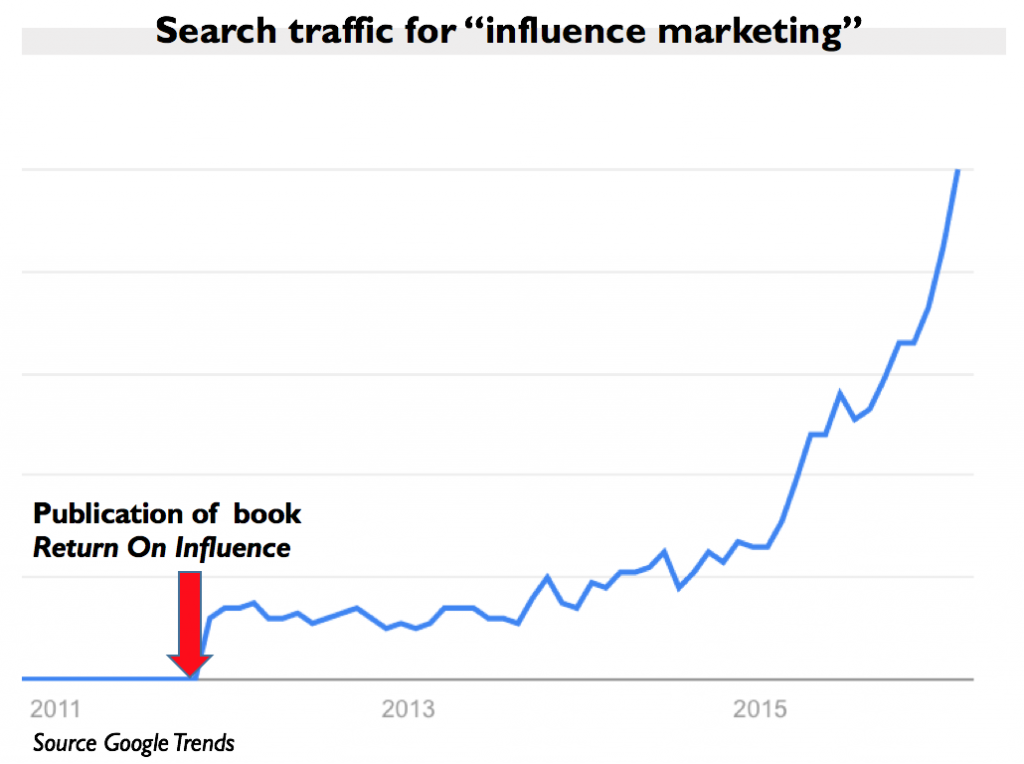
In late 2011, I turned in a manuscript for the first book on social influence marketing, Return On Influence. At the end of the book I predicted that influence marketing would become a mainstream activity within two years, a bold prediction since nobody was even using the term back then!
But my prediction did come true. The ability for everyone to publish content has democratized influence, creating a new class of “citizen influencers” who hold great power over their loyal audiences.
The halls of online influence aren’t on Wall Street or Downing Street or Madison Avenue. It’s in a café in Berlin. It’s in a college classroom in Wisconsin. It could even be in the chair you’re sitting in right now, as long as you have a connected device and an Internet connection!
Obviously brands want to get to know these YouTube stars and Snapchat gods and find clever ways to infiltrate their audiences. Interest in influence marketing has soared since the time I published my book:

I’m not claiming my book caused the trend. I’m just saying the timing of the book was … good!
In fact, influence marketing is becoming so popular that it’s becoming over-used and perhaps even mis-used. Expectations are probably out of step with what is truly possible and practical as “influencers” become inundated with requests from brands big and small.
I thought it was time to step back and take a more logical and rational view of influence marketing. How does it really fit into an overall marketing plan? When does influence marketing make sense for your business?
Here are the eight practical uses of influence marketing:
1. Finding reach when you have none
Start-ups have a big marketing problem. They’re usually running against the clock and need to attract massive attention quickly but don’t have a large and engaged audience — or the time to build one.
When I work with start-ups, I almost always consider some influencer component. The reason is simple. When you don’t have a relevant audience, you can borrow one.
2. Research: Applications for influence marketing
Working with influencers can create a powerful feedback loop as you develop new products and features. Think about it. These are people who are passionate, connected, experts in their field. Who better to give you rapid and accurate feedback on your ideas?
3. Social proof
Being aligned with celebrity influencers has been a popular marketing tool since companies began using stars like Charlie Chaplin and baseball player Babe Ruth in the 1920s. You can still get a product “glow” by having a thought leader talk about your brand.
4. Content ignition
I’ve written extensively about the fact that battling overwhelming information density is the number one issue for marketers today. The solution, which is covered in my book The Content Code, is a focus on content ignition. The economic value of content that is not seen and shared is zero.
Not everybody is suffering from Content Shock. Trusted influencers can still ignite content with just a post or a tweet. In fact there is probably no strategy more powerful (including advertising, promotion and SEO) that can ignite content and create brand awareness among a relevant audience than working effectively with influencers.
5. Site authority and SEO
Do these influencers have powerful social media platforms? You bet they do. Will a link from them to your website enhance your SEO, and ultimately your site authority? You bet it does.
6. Point of strategic leverage
Effective marketing is all about finding strategic leverage, about finding ways to maneuver that might be difficult for competitors to copy.
There are only so many influencers to go around. The influencers in your business vertical are in limited supply. If you align your brand with these thought leaders first, could that create a measure of competitive advantage?
We see this happening in the sporting goods industry. Every year the biggest brands negotiate mega-deals with the most popular stars because there just aren’t that many bankable stars. If you have them, your competitors don’t.
This is such an important advantage that some New York ad agencies are locking up exclusive relationships with YouTube and Snapchat stars, acting almost like a talent agency.
7. Cost savings
Shripal Shah, Chief Operating Officer at MOKO Social Media, was a pioneer in the use of influence marketing and was featured in my book. He told me that influence marketing can be a very cost-effective means of promotion.
“Most media campaigns are measured in terms of the cost per thousand impressions,” he said. “When the brand is being mentioned in a tweet, in a Facebook post, in a blog post, video, or comment, there’s great value to that. We are going out to people who have a huge following and a high degree of influence.
“When you do an ROI analysis, the cost per thousand impressions (CPM) I’ve seen is coming in around $1.50 to $3.00. Very reasonable. We have seen some phenomenal ROI because these tweets can lead to blog posts and the blog posts can lead to videos, the videos can then influence traditional media. We see that a lot of traditional media look at social media resources for the next story to cover.”
8. Authentic advocacy
Last, but certainly not least, is authentic advocacy.
In 2013 I was invited to attend Dell World for the first time. Dell promised me free food so I was all over that. Before the event I had a slightly negative view of Dell. I perceived them to be closely wedded to the ups and downs of Microsoft and the PC.
But once I got there, I met the people of Dell and heard Michael Dell speak on his vision for the company’s transformation as a newly-minted private company. I was totally impressed with the level of energy and innovation everywhere I turned. It was inspiring.
Over two days I became a convert and most important, Dell turned me from a slightly interested “influencer” to an authentic advocate who talks about the company and its innovations in my speeches, classes and yes, even blog posts … not because I have to, but because I want to.
Conclusion
Consider this list of potential applications for influence marketing and make a rational decision about whether this is the right technique for your business. Keep in mind that the entry barrier for some industries is getting high — when everybody is chasing the same mommy blogger or Viner, the price of access keeps going up.
If your industry is still on the ground floor of this trend, creating an influence marketing program can be a cost-effective investment with long-lasting benefits.
And remember, don’t “pitch” influencers. Befriend them. Influencers are people too!
Illustration courtesy cinemagraphs.com


